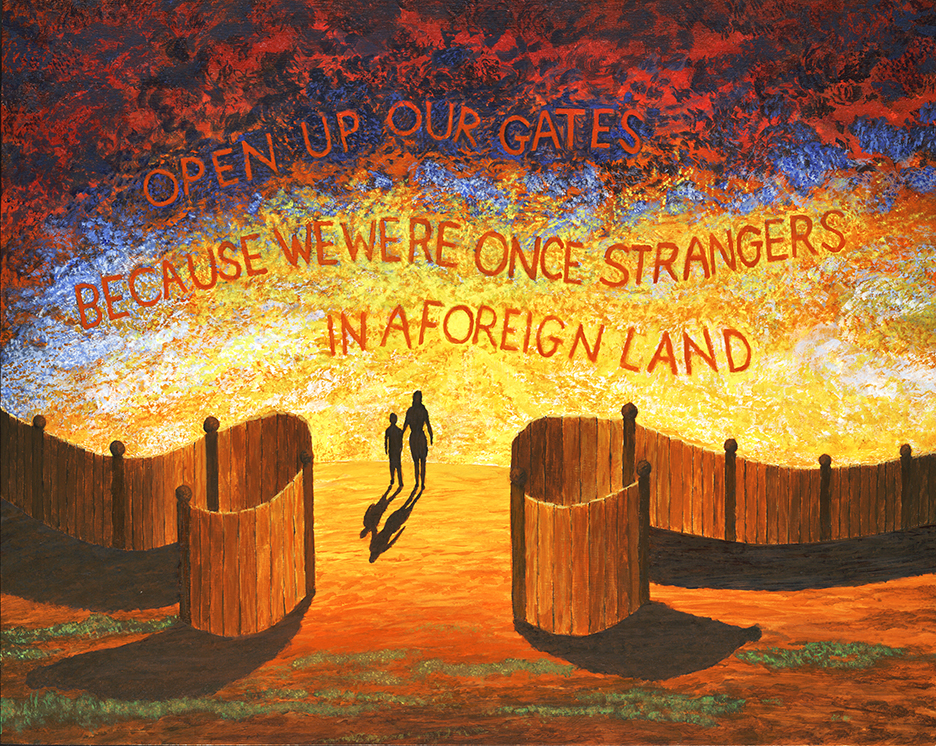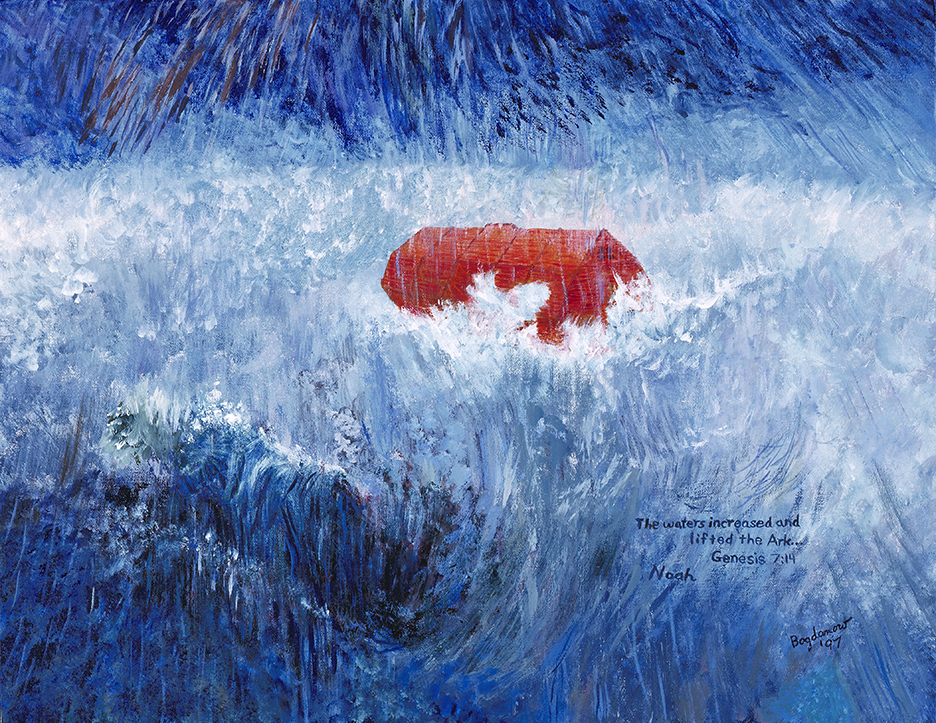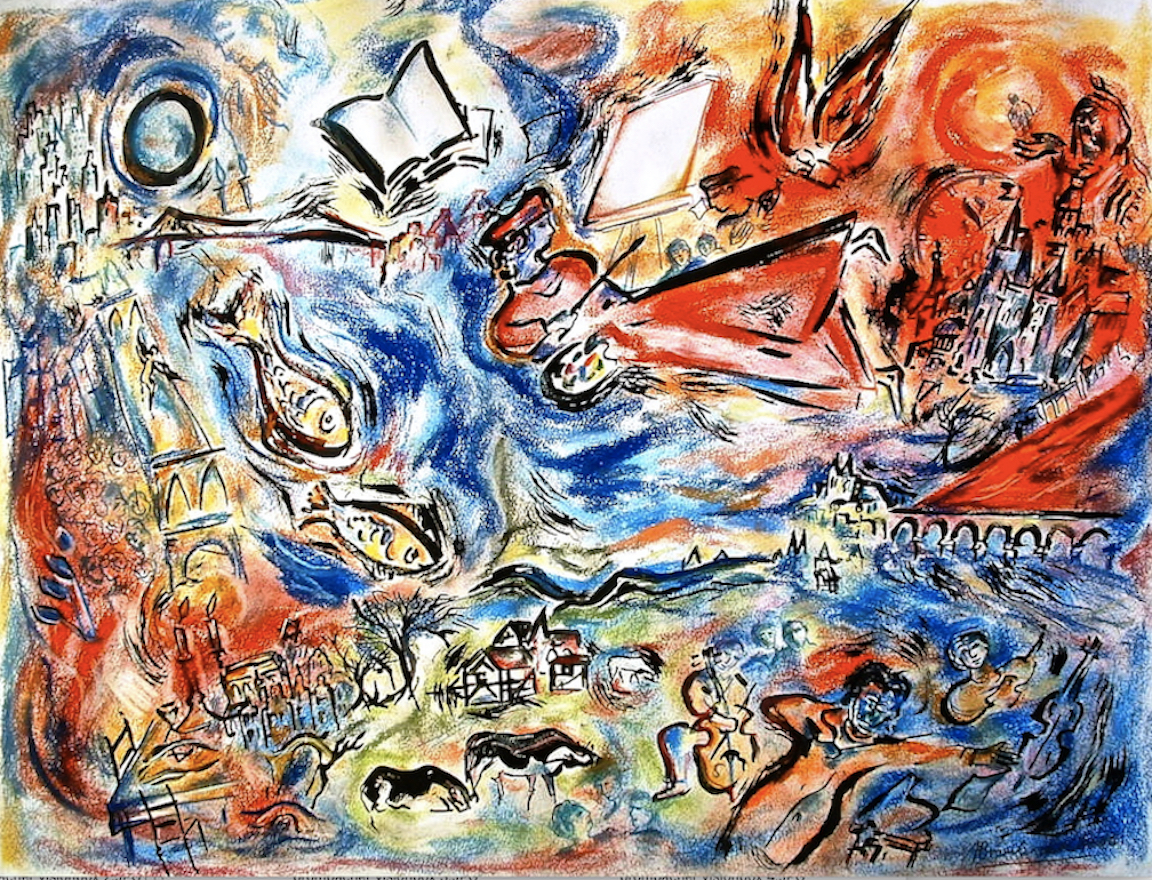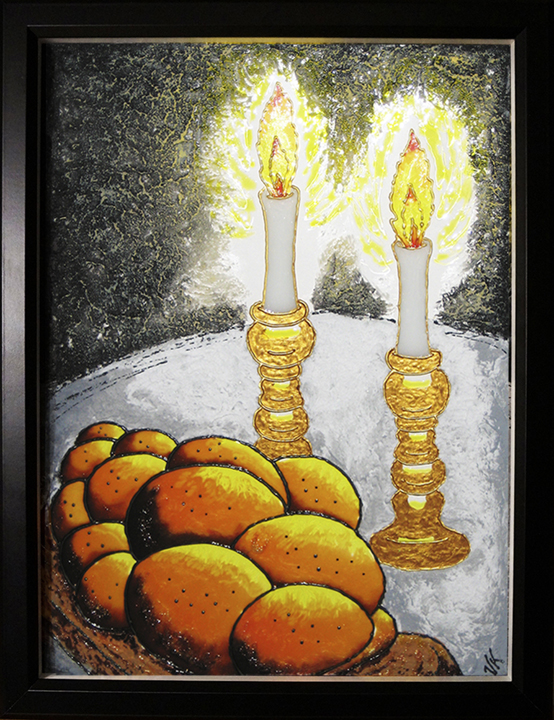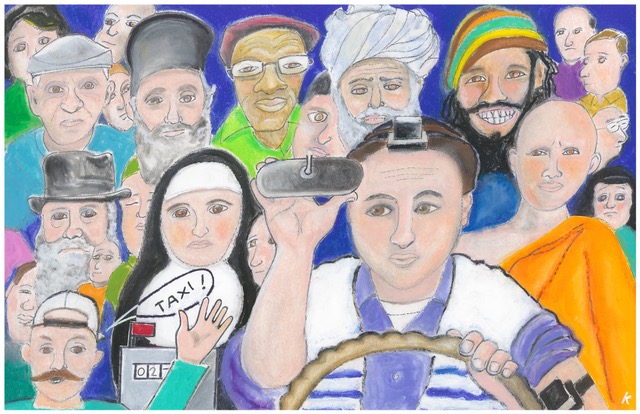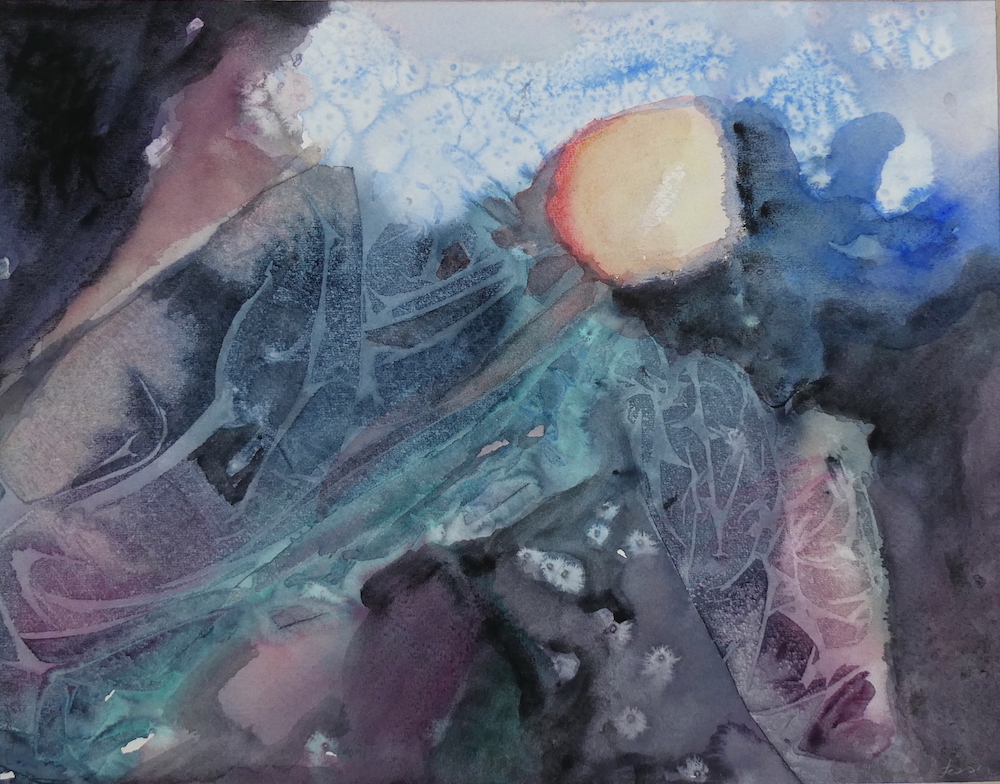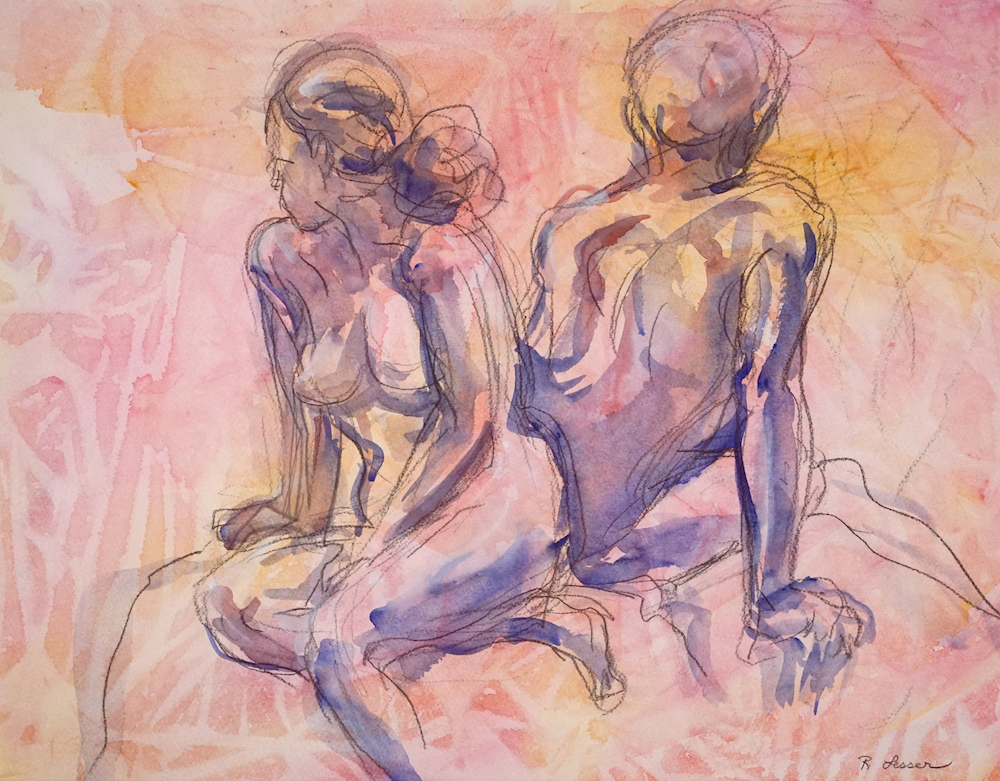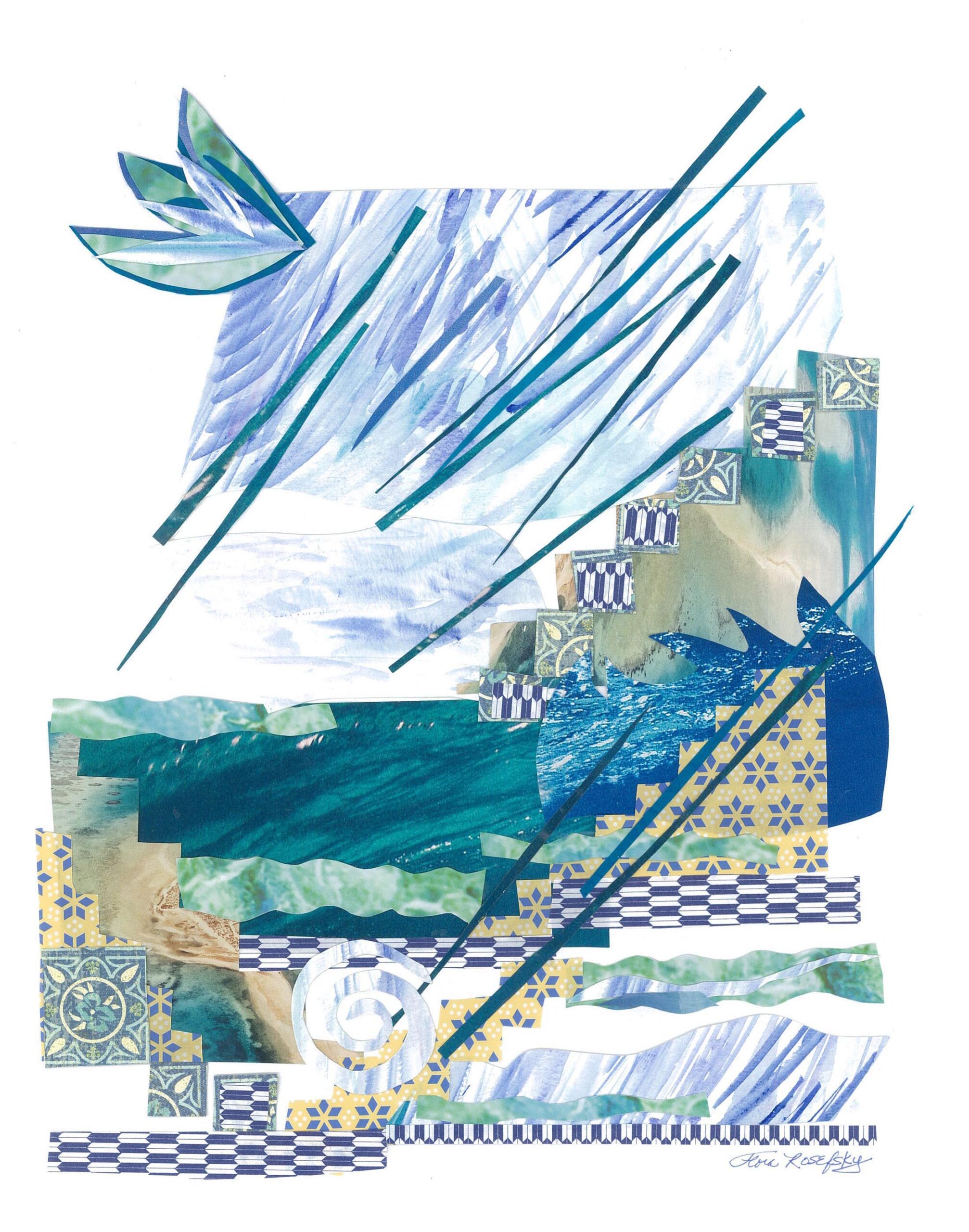Karen Walanka, z”l (1946-2018)
Karen was a long-time member of the AGJA and the Guild’s president in 2015. In 2007, Karen founded the Judaic Arts Fair in Chicago, one of most highly regarded biennials of Jewish art and culture in the United States, sponsored by Moriah Congregation. The AGJA’s annual Karen Walanka Online Exhibition is a way for us to honor Karen’s memory, her love of beauty and her life-long ambition to bring it to us all.
WALANKA 2020
This year we asked the Guild’s artists to address the theme ORIGIN STORY – to consider broad interpretations of the term in order to look, not just at the biblical origins of the Jewish people, but to consider the implications and influences of our origins. The artists dug deep – recalling both the personal and historical, and how these concepts shaped their perspectives and their artwork. As such, we have accepted work ranging from many years in the past up to the present day.
As curators, we were moved by their stories and insights, learning more about our artists and even about ourselves. In a time when outsiders are being vilified and told to “return” to their place of origin, we as a community have a moral obligation to not only welcome people of diverse backgrounds but to celebrate and appreciate the richness of their origins.
Frann Addison and Carole Landisman
Co-Curators
ORIGIN STORY
Michael Bogdanow
Haiku at the Gates (acrylic paint) 2019
“Haiku at the Gates” is a biblical Haiku, taking its text from the Torah, and altering it a bit to satisfy the 5-7-5 rhythm of a Haiku. As the theme of this year’s exhibit is Origin Story, I chose Haiku because (particularly in these times) we all need to remember that we were once strangers in a strange land – and should treat our strangers as we wish we had been treated.
Noah (acrylic paint) 1991
“Noah” captures that moment when almost everything has been lost, the peak of the flood. It is part of our Origin Story, the theme of this year’s exhibit, because it is the end of the past, with a new beginning in sight. The past is lost in the flood, the future is yet to come, and our origin is caught in between.
Nina Bonos
3 Generations (mixed media collage) 2020
This work showcases three generations of my family including:
My grandmother with 3 of her children in Berlin, Germany circa 1921, my mother, my brothers and me, San Francisco, 1956, and me, with my son and daughter, Santa Rosa, CA, 1996. I love the tenderness and pride of this collection. Since the photos were black and white, the collage adds a bit of color so as not to overwhelm the black and white images.
Rachel Braun
LeDorotam: Throughout Their Generations 2000
(Blackwork embroidery on cotton canvas, with cotton and metallic gold threads, lace applique, and beads)
Adherence to Jewish practice, one of the responsibilities of Jews of bar/bat mitzvah age, is symbolized by the tzitzit (fringes) on the corners of the tallit (prayer shawl). The book of Numbers admonishes us to look upon the tzitzit to be reminded of the commandments, describing the placement of fringes as a commandment leDorotam — for all the Israelites’ generations. I celebrated our son Hannan’s bar mitzvah by designing and embroidering part of the Biblical instruction concerning the tzitzit: “and they shall make themselves tzitzit (fringes) on the corners of their garments, throughout their generations (Numbers 15:38)”. Those words are embroidered into a tiny Aida cloth tallit, with the Hebrew word leDorotam highlighted centrally and adorned with gold metallic thread.
Hannan is named for his paternal grandfather’s mother, Hannah (Helen Braunstein, z”l), herself a needlewoman who left her family embroidered linens and doilies. I did not know Helen, but my husband remembers her well. The passage of tradition “throughout their generations” is represented by lace medallions carefully cut from a doily she tatted, with one of her medallions sewn to each corner of the embroidery work. Stylized tzitzit are tied through each one, with some of the traditional knotting patterns.
Mizrah 2003
(Blackwork embroidery on cotton canvas, with cotton threads. )
A plaque bearing the Hebrew word mizrah (מזרח , meaning “east”) often adorns the eastern wall of Jewish homes to direct our gaze and hearts toward Zion. This mizrah was designed and embroidered to mark the occasion of my daughter Molly’s bat mitzvah in 2003. The designs include characters from Molly’s favorite Jewish folktales, Talmudic stories, and books. A particular joy of raising Molly was reading her stories from our tradition, in warm embrace, in a snuggly lap, or as a moment of quiet as she drifted off to sleep. From the left are representations from these tales: Briar Rose (Jane Yellen), Joseph who loved the Sabbath (Babylonian Talmud Shabbat 119A), the diamond tree (Morocco, in The Diamond Tree, by Howard Schwartz and Barbara Rush), the spider who saved King David (Aggadah, Alpha Beita d’Ben Sira), the fox and Rabbi Akiva (Talmud, Berakhot 61b), the horse in The Wise Men of Helm (Solomon Simon), the shamir who cut the Temple stones (Pirkei Avot 5:9), the mouse of Maus (Art Spiegelman), the hoopoe bird who guarded the shamir until King Solomon cleverly secured it (Talmud, Gittin 68b), the treasure chest in The Wandering Beggar (Solomon Simon), the necklace of Number the Stars (Lois Lowry), Honi and the carob tree (Talmud, Ta’anit 23a), the magic pitcher (Iraq, in The Diamond Tree, by Howard Schwartz and Barbara Rush). Together, they tell stories of heroes and conflicts, tragedy and recovery, magic and possibility, morality and Godliness, mirth and pleasure: fiction, tales, and folklore that convey the story of a people. “God created man because He loves stories’ (Elie Wiesel). I made this piece to encapsulate stories from her childhood as she begins her journey toward adulthood.
Shoshannah Brombacher
“Durch die Welt” [Through the World] (oil paint) 1996
I chose to submit works that talk about my personal origin story, ultimately going all the way back to the biblical Israel, but here showing my own travels from my native Holland (born in Amsterdam) via the south of Holland (which has a distinctly different culture) to Jerusalem, Berlin, and New York, where I have been living for a few decades. Add to this the places I traveled which influenced me deeply. I consider my studio and my bookcases my true home. Coming from a family that values books over anything I assume my true origins are connected to books, wherever they are.
This is a small painting made in 1996, four years after I moved to New York from Berlin (Germany).Before that I lived in Leyden (Holland, close to Amsterdam, where I was born), but spent many years of my childhood in the south of Holland near the German and Belgian borders and extensive periods of times in Jerusalem. I traveled extensively. This painting expresses the kaleidoscopic feelings of a cosmopolitan Jewish artist who is nowhere completely at home and in many places partially at home, always adapting and adjusting to new environments, weighed down by history, but taking certain “fixtures” with her through the world: art, music, and melancholy. It’s the Jewish way of seeing things.
“Al ha Nisim” [Because of the Miracles] (pastel and watercolor) 2013
This painting shows the immigrant experience of many American Jews, or better, their ancestors who came across the ocean on ships from Eastern Europe in the beginning of the twentieth century. Fleeing pogroms and poverty, they could only bring a few heirlooms like the chanukiyah this woman holds in her hand. But it was enough to keep memories-and Yiddishkayt-alive. I moved to New York from Western Europe under much better circumstances but also brought a chanukiyah, a gift from my mother. Walking the streets of the Lower Eastside where my husband grew up, I felt a strong relationship with immigrants not only crossing physically a vast ocean but being immersed to the point of drowning into a completely different culture. This has its good and bad sides, it’s a mixed experience and not always easy. At times it hurts. It alienates. It’s like the irritating grain of sand inside an oyster that grows into a pearl.
“An Artist’s Life” (pastel and watercolor) 2006
“An Artist’s Life” shows the artist in the center of a tangle of different cities, landscapes and bridges depicting places where she physically lived or which influenced her life. Being Jewish means being everywhere at home and nowhere at home. The Hebrew letters in the drawing, the buildings shaped like besamim [spice] boxes or books, the candles on a Shabbat table show what a Jewish artist takes with her on her life journey and what connects her to her origins, no matter where her bookcases and easel are located. But every place she visits leaves a mark and becomes partly of the mosaic of her life.
Nancy Current
L’Dor Vador (mixed media) 2020
L’Dor Vador, from generation to generation, emphasizes the responsibility of parents and society to give their children a moral, spiritual, values-centered education. The multi-layered 9×9” glass painting uses a background of text from the Cairo genizah to represent historical teachings of the Jewish tradition, while the front layer depicts the older and younger generations.
Laurel Feldman
Almond Tree’s Blessings (photo) 2019
As I was walking I came to a stone stepped path cutting through the ancient Judean Hills. I stopped to record the glorious sight of blossoming almond trees. The beauty was spectacular and seeing nature’s wonderful sign – the almond blossoms – the birth of a new season – I was elated. A sight seen by many from the past. Perhaps, I thought Jerimiah envisioned this very spot when Hashem asked him what did he see? And Jerimiah said “I see a staff of an almond tree.” I hope this image invokes to the viewer all the possibilities of presence within their imagination.
She is a Tree of Life (photo) 2018
I took this photograph not far from Yad Vashem. It was the quintessential “Etz Chaim” (Tree of Life), as one might have envisioned in the Garden of Eden — it’s twisted trunk and many branches spreading over and sheltering us below and bearing fruit. When we return the Torah to the ark and sing “Etz chaim hee l’machazikim bah” (“She is a tree of life to those who grasp her”), I often think back on this tree in Yad Vashem.
Lois Gaylord
Guardian Kanfot (hand-dyed and painted silk) 2019
This piece was a commission for a priestess receiving her Kohenet ordination who had also just completed Guardianship training at the Kohenet Hebrew Priestess Institute, a leadership training program for female identified persons in embodied, earth based, transformative Jewish ritual).
It is a kanfot, a six cornered garment that has tzitzit in the four outer corners and is worn in place of a tallit by ordained Kohanot. She wanted a sacred garment that would feel like both the ‘Wings of Shekhinah’ and to serve as a shield when doing guardian work. (The photo was taken before the tzitzit were added.)
Invoking the names of the Matriarchs and the Archangels we decided was a powerful way to draw on the origins of our people and to bring the desired energies into the garment.
The names of the Matriarchs run down the center front and back:
Miriam for wisdom (chochmah), Leah for discernment (binah), Devorah for centeredness (tiferet, which is also compassion and truth), Sarah for strength (gevurah), Rebekah for conviction (also perseverance/netzach), and Yael & Judith for warrior energy (which is one aspect of malkhut/Shekhinah). Also included were Ruth, Rachel, and Esther.
The names of the 4 archangels: Gavriel, Michael, Uriel, Raphael, included for protection, are on the panel that sits on top of the arms when worn.
For the atarah she chose this quote: “Ozi v’zimrat yah v’hi-li l’shuah”. The Lord is my strength and song, and He is become my salvation. Psalm 118:14, Exodus 15:2 This text sits on either side of the neck when worn.
The base fabric is hand-dyed raw silk. The red fabric, also hand-dyed, is silk broadcloth. The names and the pomegranate designs in the corners are silk screened. The corners are hand-painted with dyes. The red panels are edged with black raw silk.
Harriet R. Goren
Bereshit / In the Beginning (Giclée print , 20” x 16″) 2013
Our lives are a series of beginnings—birth, new love, new jobs, life cycle milestones, discoveries large and small—and, to me, they all feel like the beginning of Genesis, as depicted in this print: chaos, tohu vavohu; the passage from darkness to light; and mysterious twists and turns that (we hope) lead to clarity and focus. [Text: Genesis 1:1-4 ]
Birth of Aleph (Giclée print, 16” x 120″) 2013
According to mystical traditions, the first letter of the Hebrew alphabet is made up of two yuds separated by vav—or you can also think of vav as spanning the gap between the two yuds. Aleph, in other words, represents “the secret of the image in which man was created [from “The Hebrew Letters”www.inner.org/hebleter/alef.htm].”* Aleph might suggest the upper and lower waters with the firmament between them, as described in Genesis, or the sensation of feeling both close to and distant from God, with the Torah in between to bridge those emotions. I think aleph represents a coming together of opposites—above and below, light and dark, good and evil—and is a reminder to seek balance between them. Maybe, in the beginning, each piece of the letter floated towards the others until finding its own glue and equilibrium, and becoming whole.
Karla Gudeon
Lilith and Eve in Eden (Original Watercolor Engraving) 2019
According to legend, Lilith was the first woman before Eve. She was Adam’s utter equal. Of course this led to problems….In my version of this creation tale, Lilith and Eve dish on Adam together.
Process:
By combining printmaking and painting, I create original paintings that spread joy.
I sketch a line drawing of my original design which is then incised into a magnesium plate. I then wipe the plate so that only the black lines are transferred to the paper when the print is pulled through the press. For each individual image in the edition, this intaglio process is repeated.
My paintings are printed on papers made by hand especially for me from jute, garlic skin, and other organic materials. Each individual sheet reflects the coming together of my ideas and my papermaker’s skills. The fiber inclusions and natural variations in the papers add charm, warmth, and character to each unique piece.
Shabbat (mixed media) 2018
Being a Jew, born in the former Soviet Union, in Ukraine, where any religious education and practice were forbidden, especially for Jews, it was always a challenge to keep our traditions. All the Jewish holidays in my family were celebrated secretly, behind closed windows. Shabbat is the gift from the Creator, the most important and recognizable symbol of Jewish Identity.
Diane Kowalski
In the Beginning (mixed media) 2020
“In the Beginning” was created using handmade silk paper that was formed to represent my vision of the first days of creation. Swirling colors of maroon, purples and blues move from darkness to light with a few embroidered night stars, showing a hint of the wonders to come. It is on a background of handwoven silk fabric. The framed size is 7” X 7”.
From Where We Came to Where We Go (mixed media collage with acrylic) 2012
Inspired by a theme of Diaspora, this work is emblematic of how Jews have spread across the world. My family on both sides came from what was then part of Russia, and now Ukraine. We eventually moved from N.Y. to Dallas, Tx. in 1961, which was another kind of Diaspora for our family. Most of us, whether Sephardic or Ashkenazi Jews can trace our history to many places on the earth as we were pushed out of one country and into another all through history.
Cindy Lutz Kornet
10 Commandments (acrylic) 2019
When Moses received the 10 Commandments from G-d, he became a changed man. His purpose and his view of life was always one of devotion to G-d. Along with the Torah they represent a roadmap for how a Jew can live a good life, bring light into this world and help repair the world
Mogen David (acrylic) 2020
This became a common symbol for Jews in the Middle Ages. It surely is one of the earliest Jewish Symbols I can remember. When the two triangles are joined together they become stronger. When each of us trusts in G-d I believe we are strengthened as well. Here the Jews and Jewish souls together gaze into the sky and sees a symbol that lets them know they are among their family of Jews.
Judith Peck
Refugees (mixed media and fiberglass) 1999
Refugees was inspired by the Kosovo uprising in Yugoslavia causing so many hundreds to flee. Of course, it is as representative of today as then, many times over with the surge of refugees fleeing danger for their lives on perilous journeys carrying only the clothes on their backs: Refugees demanding and deserving refuge and safety.
Deborah Raichman
Through The Holocaust and Modernity We Are Still Here (mixed media) 2020
My father’s Chassidishe family was annihilated by the Holocaust and assimilation. As Holocaust refugees, my parents moved to Brazil, where I was raised. My father kept strong by holding on to his love for Yiddish, Jewish tradition and our people. Growing up, my family was secular, but my father’s stories were filled with rabbis as heroes. These stories, and being surrounded by Jewish culture inspired me to reconnect with my religion and to dedicate myself to the creation of Jewish art. Now, our children and grandchildren are observant again!!
Flora Rosefsky
L’Dor V’Dor: From Generation to Generation (mixed media) 2005
Everlasting life translates into memories we cherish of those we loved, and who loved us A vintage washboard punctuates warm childhood memories of Grandma Celia, who washed clothes on such a board. Ancestors from Eastern European Shtetels, a young couple circa 1930, my husband, his father of blessed memory, and a grandchild along with a crochet doilie form their own rhythms in line and color.
Grandpa the Barber (cut-outs and ink) 2020
My grandfather Bernhard Greenbaum, the barber, came to my home where my father Henry, Uncle Bob, my brother and Bob’s two sons lined up to get haircuts in our basement. Later, out came Hungarian plum brandy Shlivovitz,”fire water”, where Grandpa raised his glass with a blessing -“L’Chaim”. As the eldest, my father told me he slept in the kitchen on his own cot, never sharing a bed with eight siblings.
Mikvah Immersion (mixed media collage) 2020
A connection between God and oneself when totally immersed in a Mikvah, the ancient Jewish ritual bath using God given water such as captured rain, is personal. This ritual originated as a commandment written in Torah over 3000 years ago, and it continues to provide self- reflection, prayer, introspection, healing and renewal, even in the 21st century.
Jovon Rosenthal
Flower Tree Of Life (ceramic with metal) 2020
The Tree of Life is a Jewish symbol of creation. After retirement, I began to make jewelry using the caning of ceramic polymer. My path through conservative Judaism inspired me to share my faith by incorporating Jewish symbols and charms into my jewelry-making. This Flower Tree of Life has been made by layering several of my ceramic flower canes. I used eight different flower canes, slicing and layering until I got the effect I wanted.
Rachel Rowen
Scheinberg Revisited Candlesticks (silver) 2016
The Scheinberg Revisited Candlesticks are a modern, cubist rendition of the candlesticks made by my great uncle Isidore Sheinberg, in Poland in 1897 (seen here: http://www.rachelrowen.co.il/RowenJudaicaSite/home/images/Scheinbok.jpg).
The modern version preserves and highlights the contours of the original candlesticks from my family’s roots in Poland, but replaces the (perhaps overly) ornate embossing of the traditional pair with a play of light and change of planes, achieved by folding the silver, almost as if making origami with paper.
Barbara Rucket
Creation: The Origin of the World (mixed media) 2011
The gloves symbolize using one’s hands to create as well as G-d holding the world he created. My mixed media folk art piece represents all seven days of creation. The needle-felted earth was stitched onto the gloves which were first sewn onto a quilted background before adding embellishments. Specific colors, fabrics and embellishments reflect the themes expressed by each “day” of the Genesis Beresheit.
To Daddy with Love and Gratitude (mixed media) 2019
In my family of origin, I am first generation on my father’s side. My father, Julian Gross, immigrated at age 6 with his mother, brother and sister from Strzemilcze, Austria in 1912, joining his father and older brother in Hartford, CT. His school picture from 1915, the ship manifest, family pictures, and some of his achievements were photo-transferred onto cloth and stitched onto fabric. Family heirloom linens and buttons were added. My father was a visionary- what was he dreaming in that picture?
Hillel Smith
Alef mural 2015
The mural features a 14+ foot tall Hebrew letter alef overlaid with abstract Hebrew calligraphy. Alef has kabbalistic significance in being the letter through with the universe was created. The calligraphy is inspired by Hebrew letterforms but does not contain many real letters and does not say anything. It is the primordial soup from which the rest of the world would be formed. Collaboration with Itamar Paloge.
She’asani Kirtzono (Jewish-gay pride mural) 2017
Included in the morning liturgy is a blessing originally written to be said by women that reads, “Blessed are you, God … for making me as intended,” in Hebrew, “she’asani kirtzono.” Re-contextualizing the blessing, this bold statement that God created each of us intentionally in these myriad bodies and forms has distinct echoes of the mantra “born this way.” As a result, this controversial blessing has become a succinct and powerful articulation of gay pride in a Jewish context.
Billha Zussman
My Jewish Backbone (mixed media) 2019
There is hardly a better metaphor for wandering and exile than the Shoe-stretcher.
The Shoe-stretcher as a symbol of immigration, immigrants and refugees. It is the most external facilitator of human locomotion, adjustment, changes, memories and commemorations. They are evoked in tandem with experiences of exile, dislocation and with nostalgia for a lost world.
My own family history has been punctuated by voluntary and imposed immigration.
Hineni & Eineni (mixed media) 2020
Sieving and being sieved or, ‘why aren’t Billha and Zilpha counted Jewish Matriarchs?’ The erasure of Billha and zilpah from our traditional consciousness is an emblem of the exclusion of marginalized women in society. Billha and Zilpha are sieved out. Sieving or being sieved. To be or not to be! I use the sieve as a metaphor for history, for the permeated separation between our body and the world, the paradox of appearing and disappearing.

